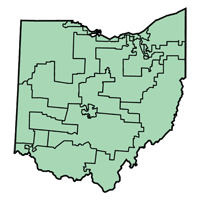Single-party control and fair map-drawing seem to go together about as well as peanut butter and trout. After all, is there anything more political than drawing the very lines that can keep politicians in power? This has been the central issue plaguing redistricting for generations. Our political system has been set up with winners and losers, where the political party in power can rig the system so it can sustain and expand its control of government. Both major political parties have done this in Ohio and elsewhere, and it has far-ranging consequences.
Partisan manipulation of the redistricting system leads to hyper-partisan districts, because officials can run for reelection without any need to appeal to a range of voters, or even to a middle ground. Fewer moderates are elected, as a high concentration of voters of one party in a single district are more likely to elect someone with views that are strongly right or left of center. As a result, majorities in legislative bodies have little incentive to work across the political aisle. Most basically, gerrymandering contradicts the will of the people, because a certain result is virtually guaranteed, no matter how they vote.
In order to help correct these problems, any reform that is put forward must provide for a map-drawing process that is non- or bipartisan. A single party may not control the process. Many states, including Ohio, implement processes for redistricting that can result in only one party controlling the process. This permits shameless power grabs and significantly damages the public, who are not adequately represented by their officials.
The ACLU does not take a position on which particular map-drawing mechanism may be best—be it the legislature, a bi-partisan commission of elected officials, or an independent commission with nonpolitical people. However, regardless of the mechanics, the process must be meaningfully non or bipartisan at every point and should be free of coercion or political deals that invariably hurt the public.
Redistricting 101: Reform Must be Equitable
Gerrymandering is also a racial justice issue, because it can lead to unfair districts that diminish the political power of people of color. While the number of Black legislators has increased over the past several decades, there is still not equal representation with the percentage of Black people in our country. The federal Voting Rights Act protects racial and ethnic minorities from discrimination in how districts are drawn, and recent lawsuits in states like North Carolina and Texas have declared maps that dilute minority power to be illegal.
There are two main ways that the voting power of people of color is diluted: packing and cracking. Packing refers to districts where mapmakers draw districts with large majorities of racial or ethnic minorities, essentially concentrating them in a single district. This often results in that district electing a person of color into an eternally safe seat, but it also leads to surrounding districts that do not reflect the racial communities that were excluded. This also means that the likelihood of electing people of color in those surrounding districts is less than if there were several districts with more diverse representation.
Cracking is the second method that partisan mapmakers often utilize, and happens when a racial or ethnic community is divided several different ways, diluting their voting power and absorbing them into other largely white districts, again leading to fewer people of color being elected into these districts. Any redistricting reform must have clear regulations to ensure that the voting power of racial and ethnic minorities is protected. It is critical that legislatures reflect our communities, and redistricting reform is one way to achieve it.
Redistricting 101: Reform must be Representative
One need only look to Ohio’s current Congressional districts to see maps that are in no way representative of communities. Several of the districts break up counties multiple times, and some cities and townships are split into different districts. Other districts sprawl across the state, winding around one another to include some communities and exclude others from its borders. It makes very little sense for people in rural Mercer County to be split into three different districts. Neighbors may be split, and then funneled into the same districts as a community three hours away on the outskirts of Cleveland.
Legislators should represent people with some degree of common interest. Splitting communities is often unnecessary and done for strictly partisan reasons. Districts should generally be compact and contiguous, allowing for maps that are sensible and representative of communities in a particular region.
Redistricting 101: Reform must be Transparent
Corruption flourishes in the dark, and most redistricting processes have been characterized by negotiations that happen in smoke-filled rooms far from the public eye. During Ohio’s last district drawing, party insiders resided in a hotel compound known as “the bunker” where they could gerrymander with abandon. Any redistricting reform must include strict transparency requirements that mandate all stages of the process be publicized and open to the public. In addition, the public should be able to comment throughout the process and when maps are finalized. Best practices would include allowing the public to present their own maps, and for the process to intentionally seek out feedback from various communities.

